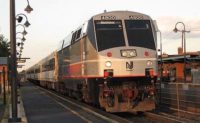Railroads Not Ready to Meet Positive Train Control Mandate

Despite a historic pace for the installation of new railroad signaling and monitoring technologies, U.S. freight and commuter railroads will not meet the Federal Railroad Administration-imposed deadline to equip infrastructure assets with positive train controls (PTCs) by Dec. 31, according to an August report from the agency.
Railroads could face penalties for non-compliance. FRA spokesman Michael Booth recently told ENR that the agency is prepared to use its enforcement tools to maximize safety, save lives and make railroads adhere to regulations. "On January 1, 2016, the [FRA] will assess each railroad's PTC implementation status and apply its enforcement tools, which include civil penalties, to bring railroads into compliance as quickly as possible," Booth says.
When it is up and running, PTC will use a network of global positioning satellites, state-of-the-art signaling systems and advanced databases to monitor and, if the need arises, automatically stop a train's movement in the event of operator error, says Ed Greenberg, spokesman for the American Association of Railroads.
While the technology is new, the deadline is not. Railroads have known about it since Congress passed, in 2008, the Rail Safety and Improvement Act.
"There was a lot of tech development, design, engineering, environmental assessments and permitting that had to be done before construction could begin," explains Chuck Baker, president of the National Railroad Construction and Maintenance Association. He adds, "Now, we are in a period of very heavy construction, but it will take at least a few more years for this entire project to be done. It's been a big source of business for railroad contractors."
The FRA's deadline looms at a time of increased political pressure on railroads that handle large shipments of crude oil, as high-profile derailments in Canada, North Dakota and Virginia over the past two years have prompted public outcry for more rail-shipment transparency and increased safety measures.
For example, in mid-August, Pennsylvania Gov. Tom Wolf (D) released a state report on oil-train safety, which examined derailment risk, tank-car failures and inspector capacity. In a statement, Wolf said he was "gravely concerned" about the risks posed by the roughly 60 shipments of crude oil weekly across the state and called for more cooperation between railroads and government.
Commuter-rail companies also have had issues with safety in recent years and might see FRA's enforcement priorities directed at them, experts say.
Alan Zarembski, the director of the Railroad Safety and Engineering Program at the University of Delaware who prepared the Pennsylvania report, says the ability of PTC to reduce, if not eliminate, "overspeed" derailments, such as a recent Amtrak derailment in the Philadelphia area and an earlier Metro North overspeed derailment, would suggest that PTC implementation of commuter- or passenger-rail systems should take a higher priority.
"Freight trains generally do not have the motive power to reach that level of overspeed," Zarembski explains.
Rail-sector equity analyst Anthony Hatch notes that PTC build-out has been slow because the critical interoperability required for the system has not yet been put in place. "It was never going to meet the arbitrary 2015 deadline," Hatch says. "It is a technology being developed."
Before the PTC mandate, rail-signal construction had been going along at a regular pace for decades, so the railroads did a lot of the work in-house, Baker adds.
"Now, the demand for contractors has reached a historic level because the mandate is forcing everybody to do this work all at the same time. There's a lot of work still out there, and the original $10 billion estimate is now proving to be low," he comments.
Much remains to be done before this new system is installed, tested and fully operational across the U.S., Greenberg says. He notes, "Reaching deadlines is important, but even more important is that, when PTC is turned on, it is fully enhancing safety."




